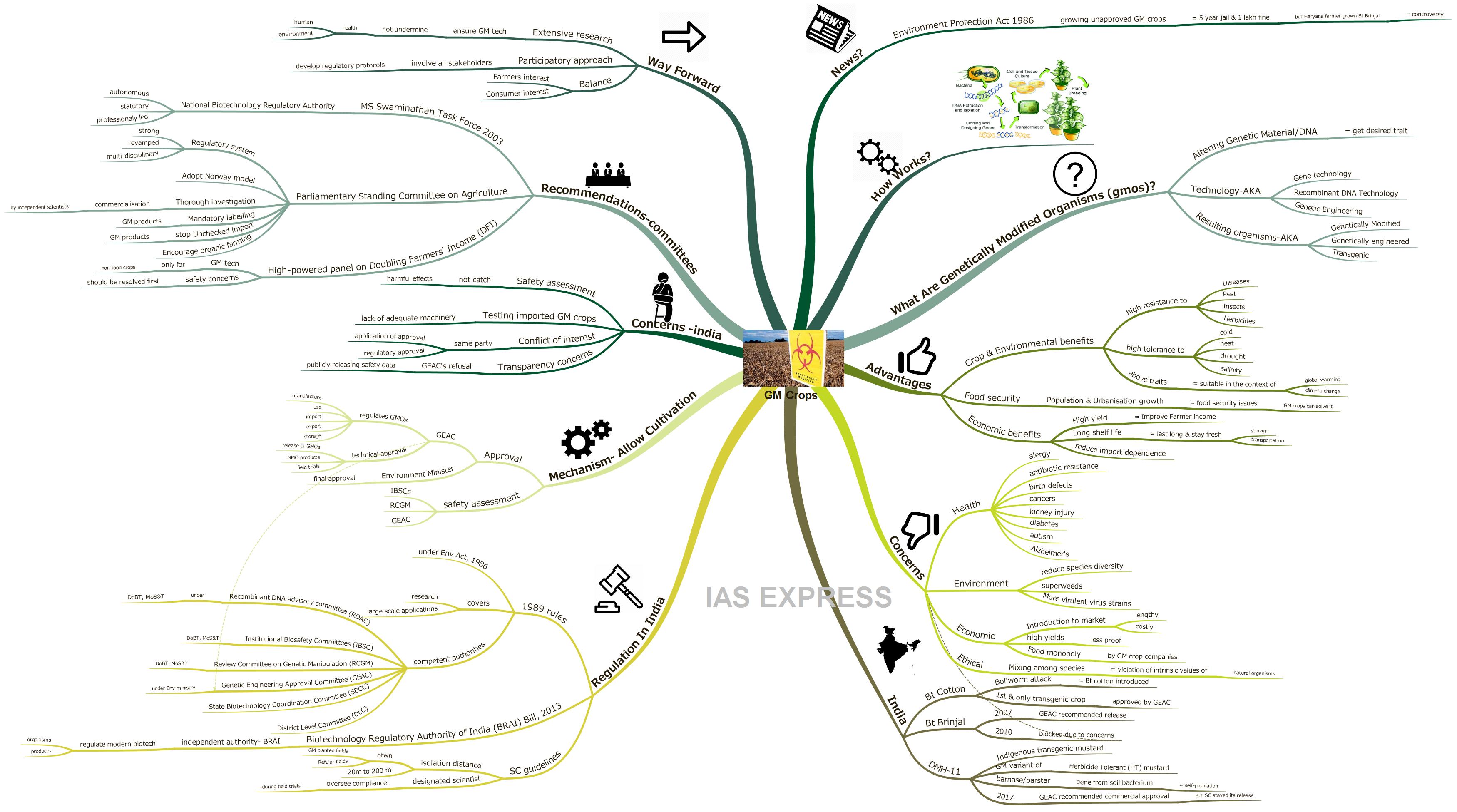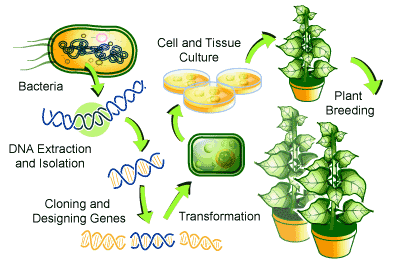GM Crops in India – Pros & Cons

Under the Environment Protection Act, 1986, growing GM crops that are not approved by the government can result in a five-year jail term and a hefty ₹1 lakh fine. Yet a Haryana farmer had grown a genetically modified (GM) variant of brinjal which is banned under the law that has landed him in controversy and the officials had forced him to uproot the crop.
There are two sides of the argument regarding GM crops – one is “regarding its potential in terms of increased crop yields & shelf life in the context of climate change events” and the other one is the “concern regarding its reliability and impacts on the environment and human health”.
What are Genetically Modified Organisms (GMOs)?
- Genetically Modified Organisms are the ones in which the genetic material (DNA) has been altered in such a way to achieve the desired quality/trait.
- This technology is often referred to as ‘gene technology’, or ‘recombinant DNA technology’ or ‘genetic engineering’ and the resulting organism is called as ‘genetically modified’, ‘genetically engineered’ or ‘transgenic’.
How does it work?
What are the advantages of GM crops?
Crops & Environmental benefits:
- GM crops have high resistance to diseases, pest, insects, and herbicides.
- Insect resistance is achieved by incorporating into the food plant the gene for toxin production from the bacterium Bacillus thuringiensis (Bt).
- Virus resistance is achieved by means of the introduction of a gene from certain viruses which cause disease in plants.
- Herbicide tolerance is achieved via the introduction of a gene from a bacterium having resistance to some herbicides.
- They also have a high tolerance to cold/heat, drought, and salinity which is helpful in the context of global warming and climate change.
Food security: Considering the huge growth of the global population and urbanization, GM crops provides one of the promising solutions to meet the world’s food security needs.
Economic benefits:
- GM crops improve yield, thus increasing farmers income.
- GM crops have longer shelf life = improves how long they last and stay fresh during transportation and storage.
- GM crops can help reduce the dependence on imports especially oilseeds.
What are the concerns with GM crops?
Health concerns:
- The potential impact on human health including allergens (any substance that can cause an allergy) and transfer of antibiotic resistance markers.
- Studies have shown a strong correlation between GM crops and Birth defects, cancers, kidney injury, diabetes, autism, and Alzheimer’s.
Environmental concerns:
- They can decrease species diversity. For example, insect-resistant plants might harm insects that are not their intended target = destruction of that particular insect species.
- GM technology could also result in the transfer of genes from one crop to another, creating “superweeds”, which will be immune to common control methods.
- Viral genes added to crops for the purpose of viral resistance could be transferred to other viral pathogens, which can result in new and more virulent virus strains.
Economic Concerns:
- Introduction of a GM crop to market is a time-consuming and costly process.
- It does not provide high yields as promised. For instance, the highest yields in mustard are from the 5 countries which do not grow GM mustard — U.K., France, Poland, Germany and Czech Republic — and not from the GM-growing U.S. or Canada.
- Furthermore, the patent provides GM crops developers a dangerous degree of control over the food supply = concern of the domination of world food production by a few companies.
Ethical Concerns:
- GM crop is the violation of natural organisms’ intrinsic values by mixing among species.
- There have also been oppositions to mixing animal genes in plants.
GM Crops in India
BT Cotton:
- In order to tackle the bollworm attack that had devastated cotton crops in the past, Bt cotton was introduced which was jointly developed by the Maharashtra Hybrid Seeds Company (Mahyco) and the US seed company Monsanto.
- In 2002, the Genetic Engineering Appraisal Committee (GEAC) had approved Bt Cotton for commercial cultivation in 6 states such as Andhra Pradesh, Gujarat, Karnataka, Madhya Pradesh, Maharashtra, and Tamil Nadu. It has to be noted that, Bt cotton is the first and only transgenic crop approved by the GEAC.
BT Brinjal:
- Mahyco jointly developed Bt Brinjal with Dharwad University of Agricultural Sciences and the Tamil Nadu Agricultural University.
- Even though GEAC in 2007 had recommended the commercial release of Bt Brinjal, the initiative was blocked in 2010.
HT Mustard:
- Dhara Mustard Hybrid (DMH-11) is an indigenously developed transgenic mustard. It is a genetically modified variant of Herbicide Tolerant (HT) mustard. It was developed with barnase/barstar technology to modify/add genes from soil bacterium in order to make mustard self-pollinating plant.
- In 2017, the GEAC recommended the commercial approval of the HT Mustard crop. However, the Supreme Court stayed its release and asked the central government to seek public opinion.
How GM Crops are regulated in India?
1989 rules:
- The Rules for the Manufacture, Use, Import, Export, and Storage of Hazardous Micro-Organisms/ Genetically Engineered Organisms or Cells, 1989, or in short, the Rules, 1989.
- Ministry of Environment & Forests notified it under the Environment (Protection) Act, 1986.
- Encompasses both research as well as the large scale applications of the GM crops.
- Also, define the competent authorities and composition of such authorities for the handling of different aspects of the rules. The Competent Authorities are as follows:
- Recombinant DNA Advisory Committee (RDAC) under the Department of Biotechnology, Ministry of Science and Technology
- Institutional Biosafety Committees (IBSC) under the Department of Biotechnology, Ministry of Science and Technology
- Review Committee on Genetic Manipulation (RCGM) under the Department of Biotechnology
- Genetic Engineering Approval Committee (GEAC) under Environment Ministry for regulating the manufacturing, use, import, export and storage of hazardous micro-organisms or genetically engineered organisms (GMOs) and cells in the country.
- State Biotechnology Coordination Committee (SBCC)
- District Level Committee (DLC)
Biotechnology Regulatory Authority of India (BRAI) Bill,2013 has been drafted to create an independent authority, the Biotechnology Regulatory Authority of India (BRAI), to regulate organisms and products of modern biotechnology.
Supreme Court Guidelines:
- Isolation distance between the GM-planted fields and regular fields to be increased from 20 metres to at least 200 metres.
- During the field trials of GM crops, a designated scientist should make sure that all the conditions were complied with.
What is the mechanism to allow cultivation of GM crops in India?
- Genetic Engineering Approval Committee (GEAC) is apex authority under Ministry of Environment, Forests and Climate Change for regulating the manufacturing, use, import, export and storage of hazardous microorganisms or genetically engineered organisms (GMOs) and cells in India.
- GEAC is also responsible for providing technical approval of proposals with respect to the release of GMOs and products including experimental field trials.
- But Environment Minister gives final approval for GMOs.
- The safety features of GM crops are assessed by – the Institutional Biosafety Committees (IBSCs), Review Committee on Genetic Manipulation (RCGM) and Genetic Engineering Appraisal Committee (GEAC) established under Rules 1989 of Environment Protection Act (EPA) 1986 – with respect to Biosafety Guidelines and the Standard Operating Procedures.
- Approval of transgenic crops is based on a policy of case-by-case basis.
- According to the guidelines framed by the ICMR, safety assessment is designed to identify the presence of any hazard, nutritional or other safety concern.
What are the concerns in India?
- Assessment: According to critics, the present safety assessments are insufficient to catch most of the harmful effects of GM crops. Because the regulatory regime in India has never assessed the GM crops thoroughly with respect to the Indian conditions.
- Imported GM crops: There is a lack of sufficient machinery to test the imported GM crops. There is only one Food Lab in Kolkata under the Ministry of Health and which is not well-equipped.
- Conflict of interest: All the safety tests for regulatory approvals in India are conducted by the same party that applies for commercialisation of GM crops as well.
- Transparency concerns: GEAC’s refusal to publicly release the safety testing data submitted for regulatory approval of BT Brinjal and GM Mustard, until GM opponents submitted a Right to Information petition has raised serious concerns over transparency. The tendency to operate in secrecy has created a serious distrust on the government and the promoters of GM crops.
What are the Recommendations of committees?
Task Force under the Chairmanship of Prof. M.S. Swaminathan, 2003: suggested the establishment by an Act of Parliament an autonomous, statutory and professionally led National Biotechnology Regulatory Authority.
Parliamentary Standing Committee on Agriculture, in its new report, “Cultivation of Genetically Modified Food Crops — Prospects and Effects made the following major recommendations:
- The government must not allow field trials of GM crops until there is a strong, revamped, multi-disciplinary regulatory system in place. The Committee studied the regulatory system in several countries and found that the one in Norway is the best.
- A thorough investigation must be conducted into the permission provided for the commercialisation of Bt Brinjal right from the beginning till a moratorium was imposed in 2010.
- The government should assess the research reports and assessment by independent scientists of Bt Brinjal by any agency other than the Genetic Engineering Approval Committee (GEAC), which gave approval on its own assessment, to avoid conflict of interest.
- Re-evaluation of all research findings in Bt cotton seeds in the context of studies that highlighted unexplainable changes in the organs and tissues of Bt-cotton seed-fed lambs.
- Mandatory labeling of products from GM crops.
- Unchecked import of GM products should be stopped.
- Encourage organic farming.
High-powered panel on Doubling Farmers’ Income (DFI): made the following observations:
- Genetic Engineering is a ‘powerful’ tool for growing future crop, but for now, it should be adopted only for non-food crops.
- For transgenic food crops, questions on its safety must be resolved and settled first.
What needs to be done?
- Research: A primary challenge today is to develop low-input, high-output agriculture. This cannot be achieved without technology. However, there needs to be extensive research to ensure that technology does not undermine human and environmental health.
- Participatory approach: The Indian government should take decisions on GM technologies according to scientific evidence. It should adopt a participatory approach for bringing together all stakeholders to develop regulatory protocols. This would create trust in the whole process.
- Farmers interest: Any new technology adopted in the farming sector should be in the interest of the farmers without affecting the rights of consumers.
- Convince all stakeholders: The most important job for the promoters of GM technology is to convince consumers, environmental activists, and farmers, that among several alternatives exist for sustainable food production, GM technology is one of the best options to improve crop yields and resolve India’s food security concerns.
The Food and Agriculture Organization (FAO) has rightly declared in 2004 that, “Science cannot declare any technology completely risk free. Genetically engineered crops can decrease some environmental risks associated with conventional agriculture, however, it will also introduce new challenges that should be effectively addressed”.
Practice Questions
- Critically analyse whether it is essential to go the GM way for a solution to the hunger crisis? (250 words)
- Critically examine the benefits and risks with regards to GM foods. Also, discuss the regulatory mechanism in India dealing with GM foods. (250 words)
If you like this post, please share your feedback in the comments section below so that we will upload more posts like this.




Audio file missing. Request add this functionality for ease of understanding. Thanks
really outstanding work in the pic explaining GM crops.